Description
The biwa is a four stringed lute and it is approximately 106 cm long (42 inches).
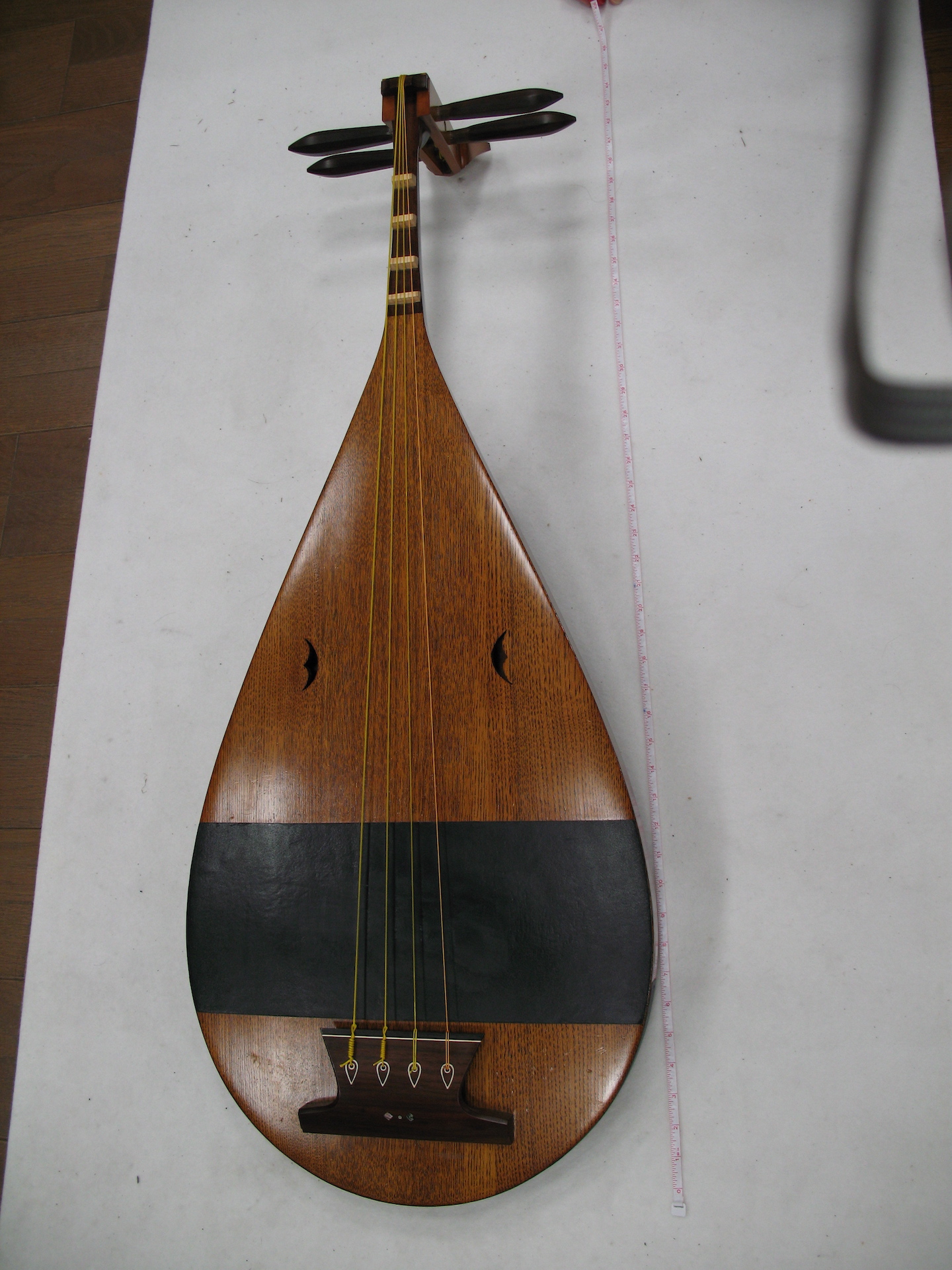 Biwa
Biwa
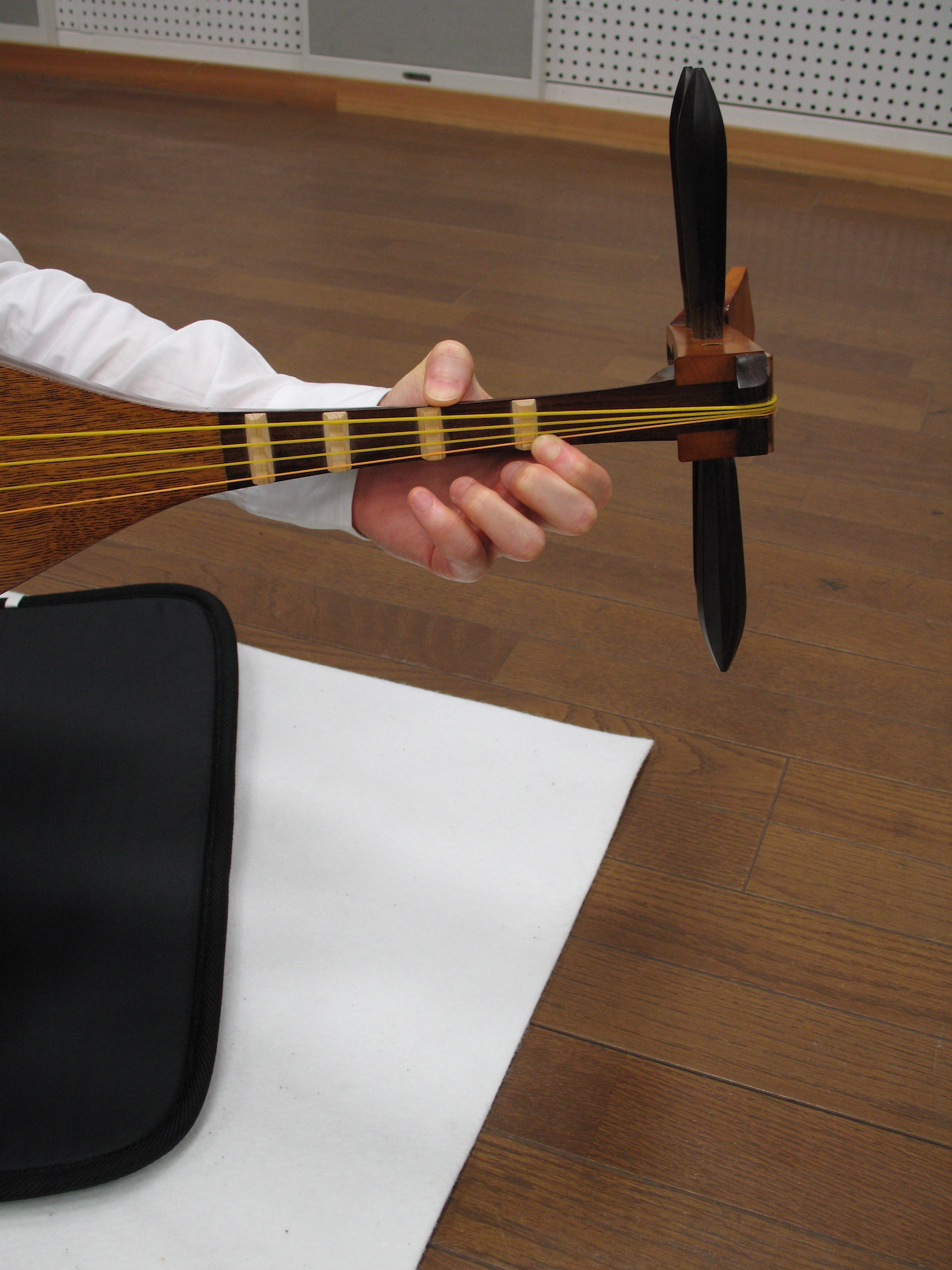 Four frets
Four frets
Figure 1
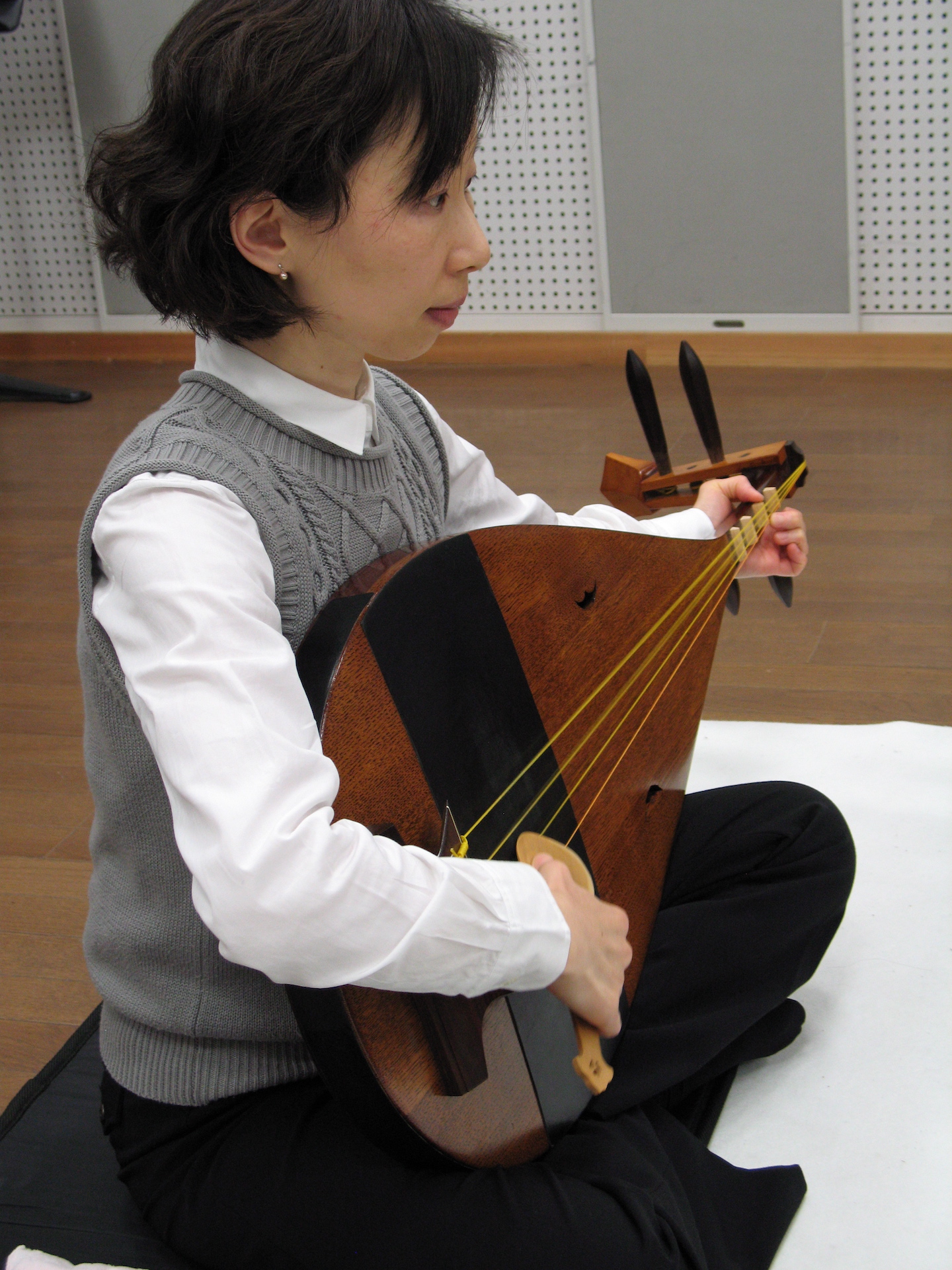 NAKAMURA Kahoru
Biwa’s back is flat
NAKAMURA Kahoru
Biwa’s back is flat
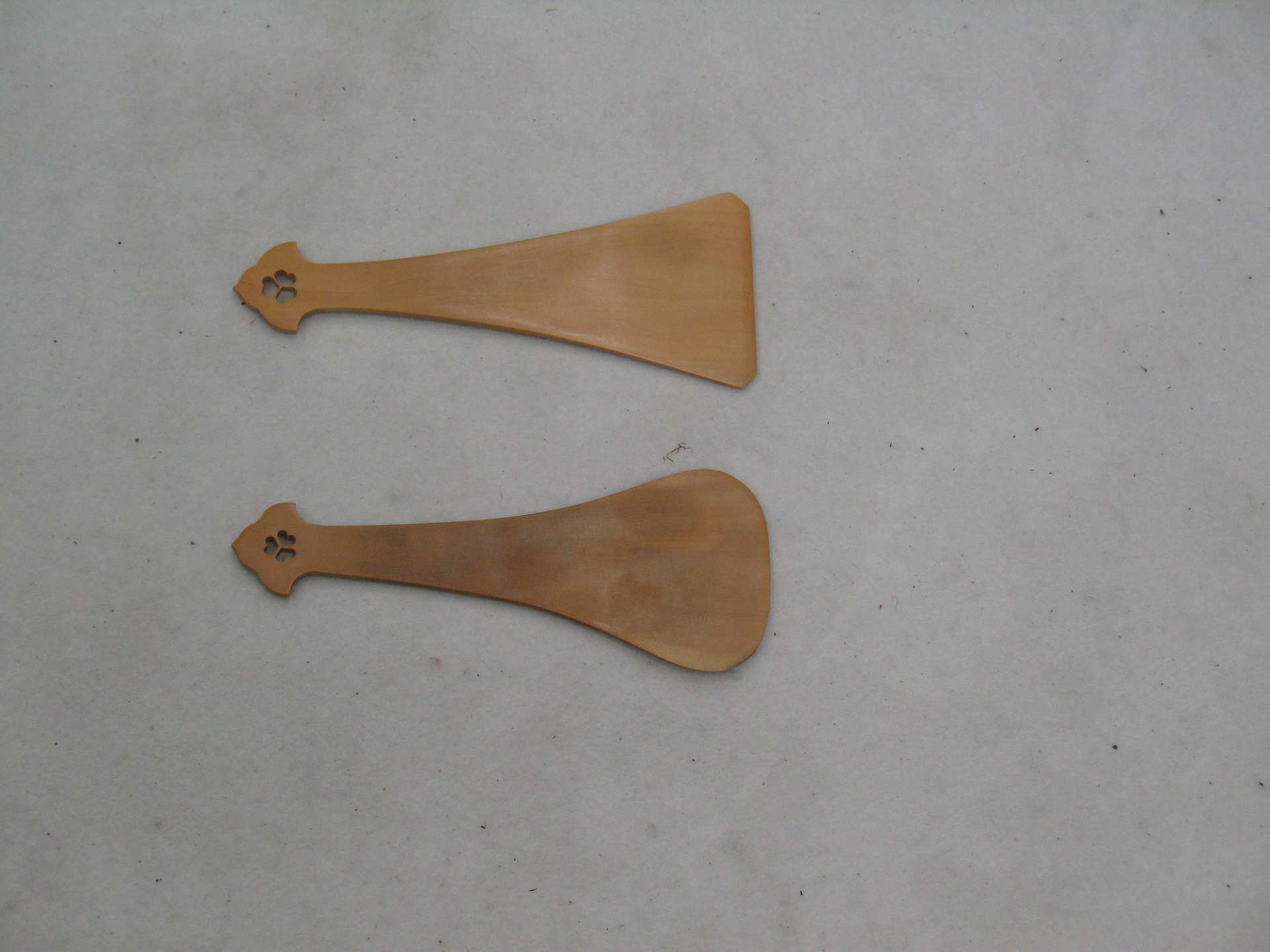 Biwa’s plectrum
Biwa’s plectrum
Figure 2
Although shaped like a Western lute, the Biwa's back is flat and it has a shallower body. The short neck has four raised frets, each one specifically assigned to one of the left hand fingers. The strings are struck with a hand-held wooden plectrum.
Tuning
The biwa sounds as written, and it is tuned to an A-430Hz. The strings are numbered from the lowest (first string) to the highest (fourth string). The tuning of the strings changes according to the piece’s mode. Since the biwa’s pegs do not move smoothly, tuning the instrument to a different mode requires time.
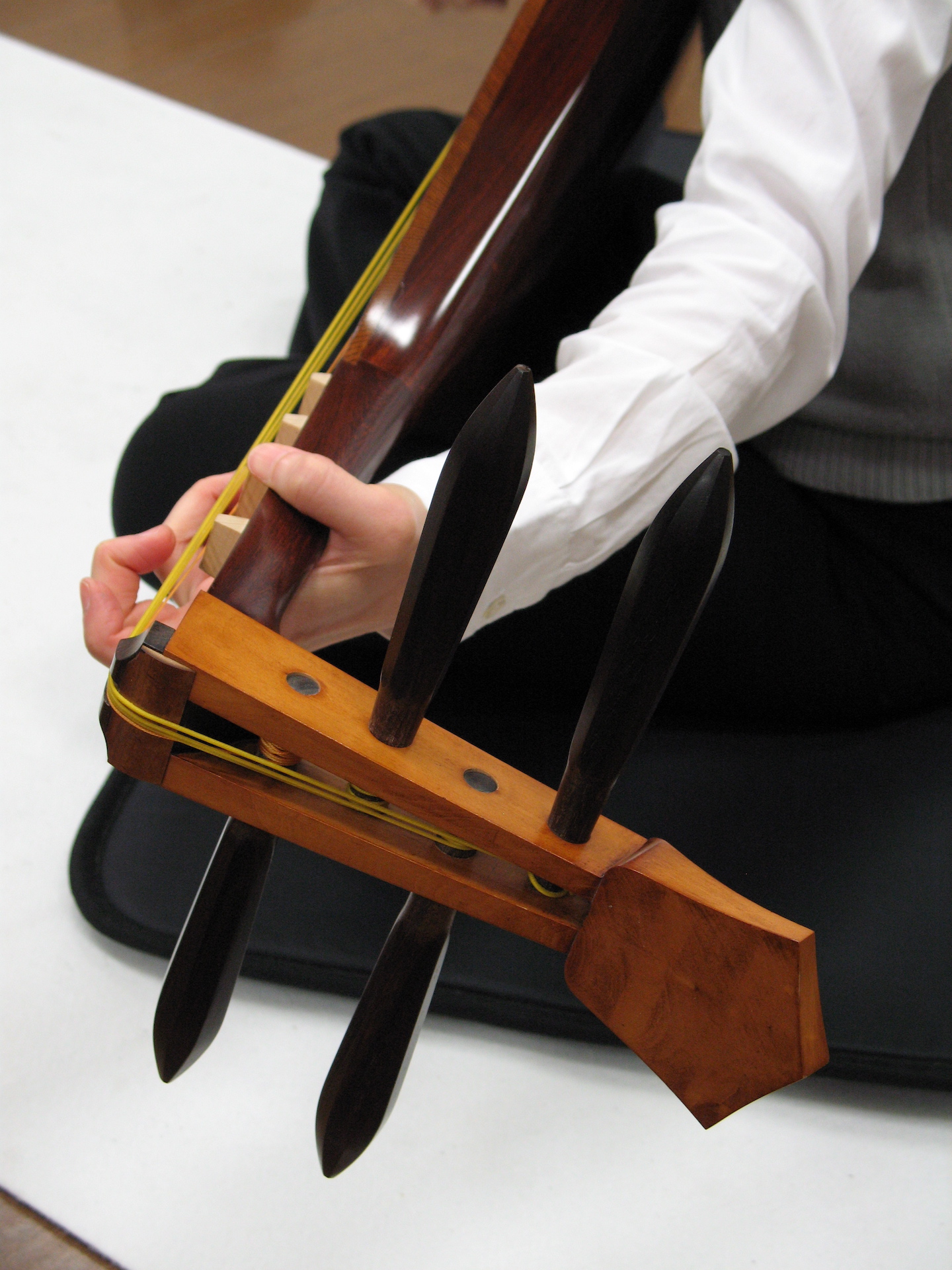 Biwa's pegs
Biwa's pegs
Figure 3
NAKAMURA Kahoru, the biwa player with whom we worked, mentioned that for a concert including pieces in two different modes, she tunes two biwas before the concert. Figure 4 introduces the biwa’s six traditional tunings. The open strings are shown in the first measures, and the pitches assigned the left-hand fingered notes in the following four measures. The interval between the pitches of the open string and first fret is a major second, while the interval between pitches on two adjacent frets is a minor second.
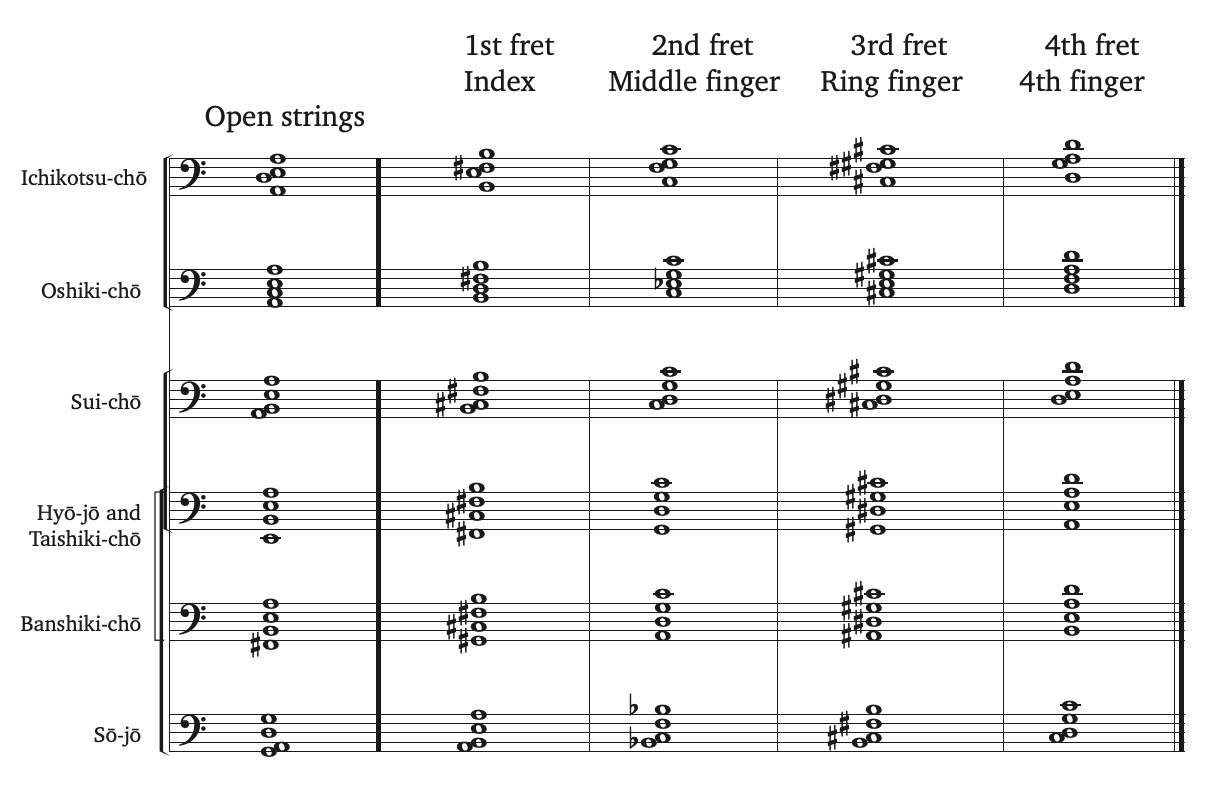 Biwa’s tunings
Biwa’s tunings
Figure 4
The biwa’s shallow body is a bouncing board that sharply projects its sound forward. Therefore the sound of the biwa is very strong at the attack but it has almost no resonance, and in that sense, its contribution to the overall sound of the orchestra is more rhythmic than harmonic. In order to boost the volume of its sound the biwa player rarely attacks a single string, and instead arpeggios 2, 3, or 4 pitches, with one note per string. The stroking motion always starts from the 1st string, sequentially sweeping toward the others until it reaches the arpeggio’s last string. Figure 5 shows examples of harmonic structures of, 2, 3, and 4 pitches in Ichikotsu-chō.

|
||
|
Arpeggios of 2, 3 and 4 notes |
||
Figure 5
Figure 6 shows a spectral analysis of the arpeggio read at the attack and one second later. It helps illustrate the neglible amount of resonance the biwa produces, because already after 1 second most of its sound energy is below the threshold of hearing.
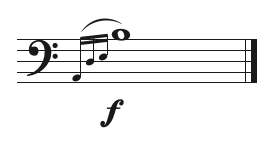
|
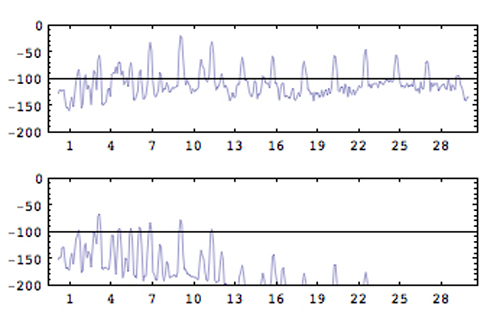
|
At the attack |
| One second later |
The biwa’s sound at the attack (top) at one second later (bottom)
Figure 6
Typically, the lowest notes of the arpeggios are open strings, while the highest ones can either be fingered pitches or an open string. Exploiting the sound of the open strings increases the overall sound’s volume. It is possible to include a fingered pitch among the lower grace-notes but that pitch should preferably be chosen among those playable on the 4th fret. This is due to the fact that the space between the strings on the first three frets is so short that a fingered 1st fret on the 3rd string, for example, would damp the following 4th string, as shown on Figure 7. Finally, it is not customary to finger more than one pitch within a harmonic structure, so if a fingered pitch were to be included among the grace-notes, then the last pitch would need to be an open string.
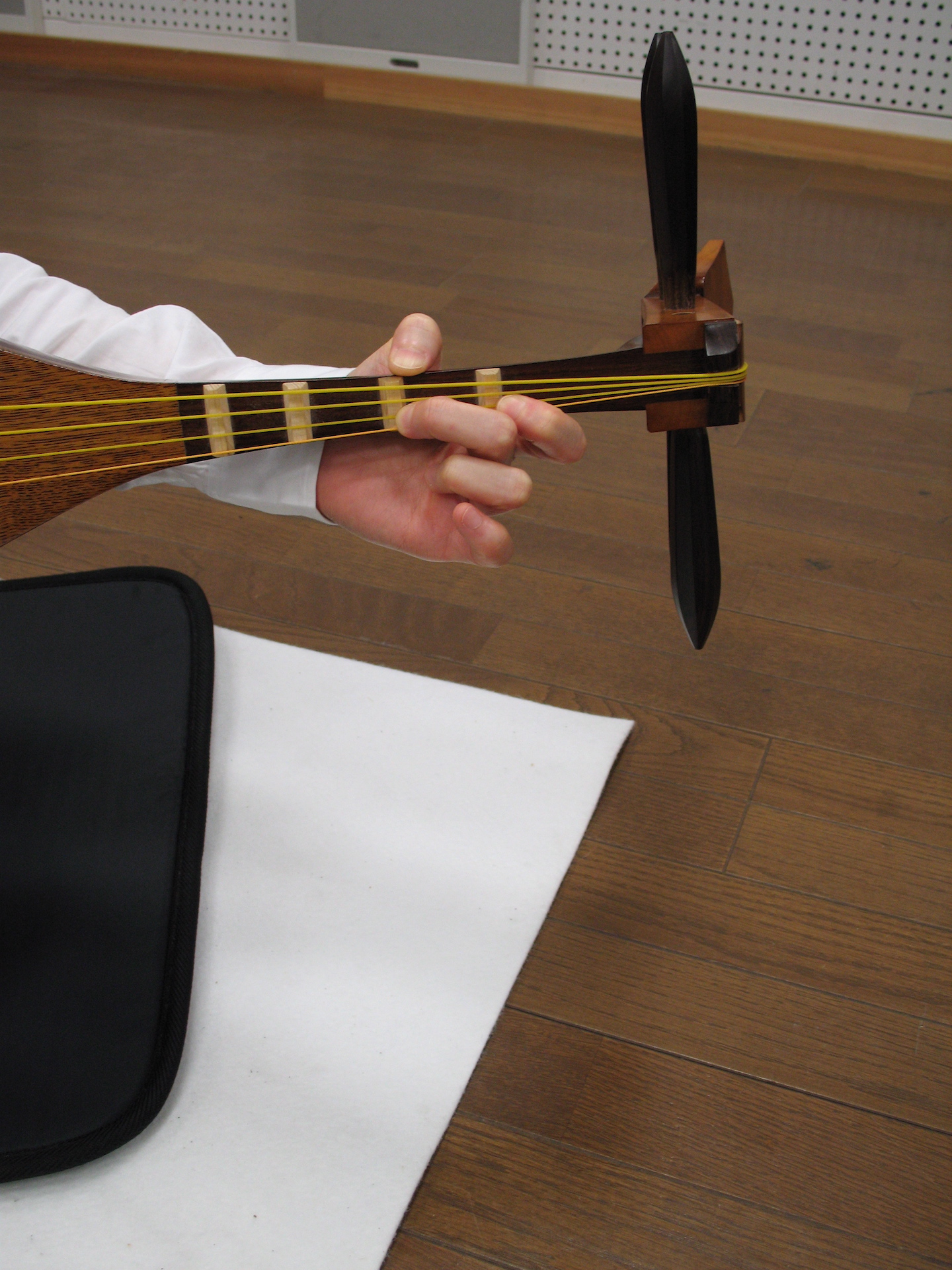 There is little space between the strings on the first three frets, causing obstruction when attacking an upper string whose immediate lower string is fingered in one of the first three frets.
There is little space between the strings on the first three frets, causing obstruction when attacking an upper string whose immediate lower string is fingered in one of the first three frets.
Figure 7
Traditional performance practices
Kakubachi: This is the performance of arpeggio with a downward motion of the plectrum, and it is always loud. Moreover, it always starts from the 1st string and stops on either the 2nd, 3rd, or 4th string depending if the arpeggio contains 2, 3, or 4 pitches, respectively.
Kaeshibachi: The performance of arpeggio with an up-ward motion of the plectrum, and it is always soft. The method of holding the plectrum is different when performing kaeshibachi or kakubachi, and consequently composers need to allow a few seconds for the repositioning of the hand when using the two techniques in sequence. It always starts from the 4th string and stops on either the 3rd, 2nd, or 1st string depending if the arpeggio contains 2, 3, or 4 pitches, respectively.
| Kakubachi in Ichikotsuchō | Kaeshibachi in Ichikotsuchō |

|
|
Example 1
Waribachi: This is a downward sweeping of the four strings, dividing the motion into two groups of two notes. Each group can include either two open strings or one open and one fingered string. Typically, the duration of each group subdivides the measure into two equal durations.
Kakisukashi: This is a three or four-note arpeggio with two strings in unison. Options are limited when considering that a fingered string between two open strings must be fingered on the 4th fret to avoid damping.
| Waribachi in Ichikotsuchō | Kakisukashi in Ichikotsuchō |

|
|
Example 2
Hazusu: This is a sequence of two pitches, where the first one is attacked, and leades to a second one which is not attacked. Typically, the second pitch is fingered on the same string one or two frets lower than the first one, and the note is attacked and then lifted off into the second fret position. Traditionally, the duration of each pitch subdivides the measure into two equal durations.
Tataku: This is similar to hazusu, except that this time, two non-struck pitches follow the struck one. Traditionally, the 2nd pitch either acts as a lower neighboring tone or a descending passing tone. Typically, the three-note rhythm is either short-short-long or long-short-short.
In both cases, the sound of the non-struck pitches is not hearable when performed with the orchestra, but the gesture itself might help the biwa player keep time. Considering that the metronome marking of this music rarely exceeds the quarter-note at 54, and that the biwa plays mostly on the 1st beat of each measure, it is the authors’ impression that hazusu and/or tataku may help the biwa player keep time by providing material/action that cuts the duration of a measure in two, even if it cannot be heard. The exception for these methods is for when hazusu or tataku are performed on the 4th string. In this case, the left hand fourth finger taps the string so that the un-attacked pitch or pitches can be somewhat heard.
| Hazusu in Ichikotsuchō | Tataku in Ichikotsuchō |

|
|
Example 3
Example 4 shows the basic melody of Etenraku's section B and C, and its rhythmic accompaniment. Its purpose is to show in context how the biwa uses its various patterns to color some melodic tones. The phrase structure is of four measures of four beats, and each section is composed of two phrases. The piece is in Hyō-jō mode (E Dorian) and the basic melody is centered on the pitches: E, B, and A, three of the four fundamental pitches of the Japanese modes.
Example 4 also shows the biwa's standard one-measure motive. It is an arpeggio that is always starting from the first string (the lowest) and swepping upwards to either the second, third or fourth string. Typically, the lower strings of the arpeggio are open, as indicated with the '0' in Example 4, while the last string hit may either be open or fingered (numbers 1 to 4 refers to the left hand's fingers from the index to the 4th finger, respectively). As a point of clarification, the highest and last pitch of the biwa's arpeggio is considered as its melodic pitch. The sole stroke motion used in this example is kakubachi, but it also includes examples of hazusu and tataku.
Example 4 shows that the biwa's melodic pitch doubles the basic melodic tone on the downbeat of almost every measure, except in measure 4 where the melodic tone 'E' is supported with a 'D' in the biwa's part. We speculate that being half-way in the section, the purpose of this clash may be to avoid a too strong feeling of cadence on the 'tonic E,' since there is one more phrase to come before completing this section. Finally, measure 5 shows a rare instance where a melodic tone (F# in this case) is doubled on the second beat of the biwa's pattern.
The excerpt is performed by the ensemble Reigakusha.
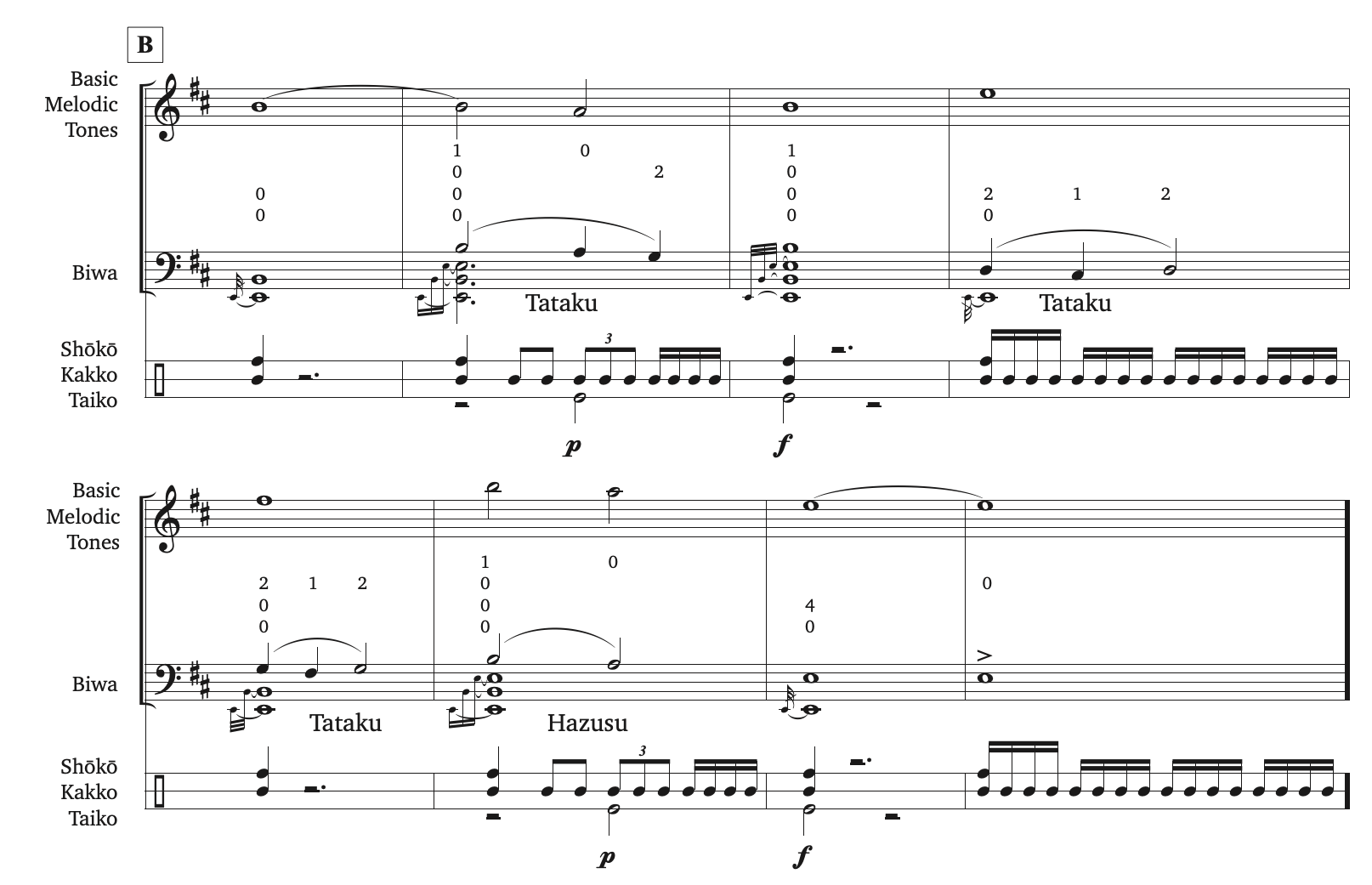
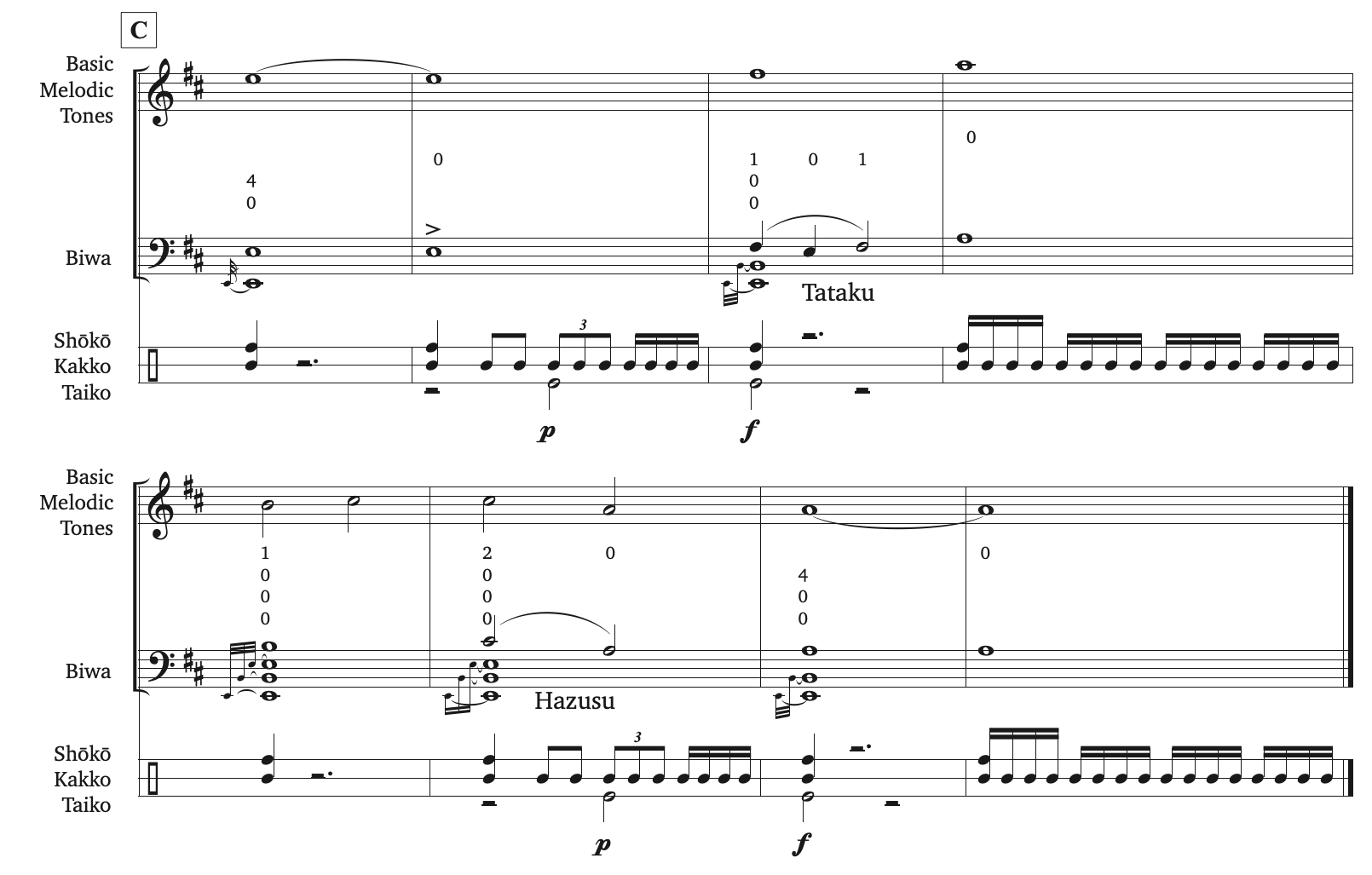
Example 4
New Performance practices
Rubbing the strings: The plectrum is used to rub an open string.

|
Example 5
Hitting the body of the instrument: The plectrum is used to hit the black protective part on the front of the instrument. The sound can be totally different depending on where the instrument is hit, how the plectrum is held, and which part of the plectrum hits the surface. The biwa player with whom we worked, NAKAMURA Kahoru, improvised ten different versions of this rhythm.

|
Example 6
Harmonics: The 2nd, 3rd, and 4th harmonics of each open string can be performed by attacking the string with either the plectrum or the finger, and in both cases, the overall sonority is quite soft.

|
|
|
Harmonics with fingers |
Harmonics with plectrum |
Example 7